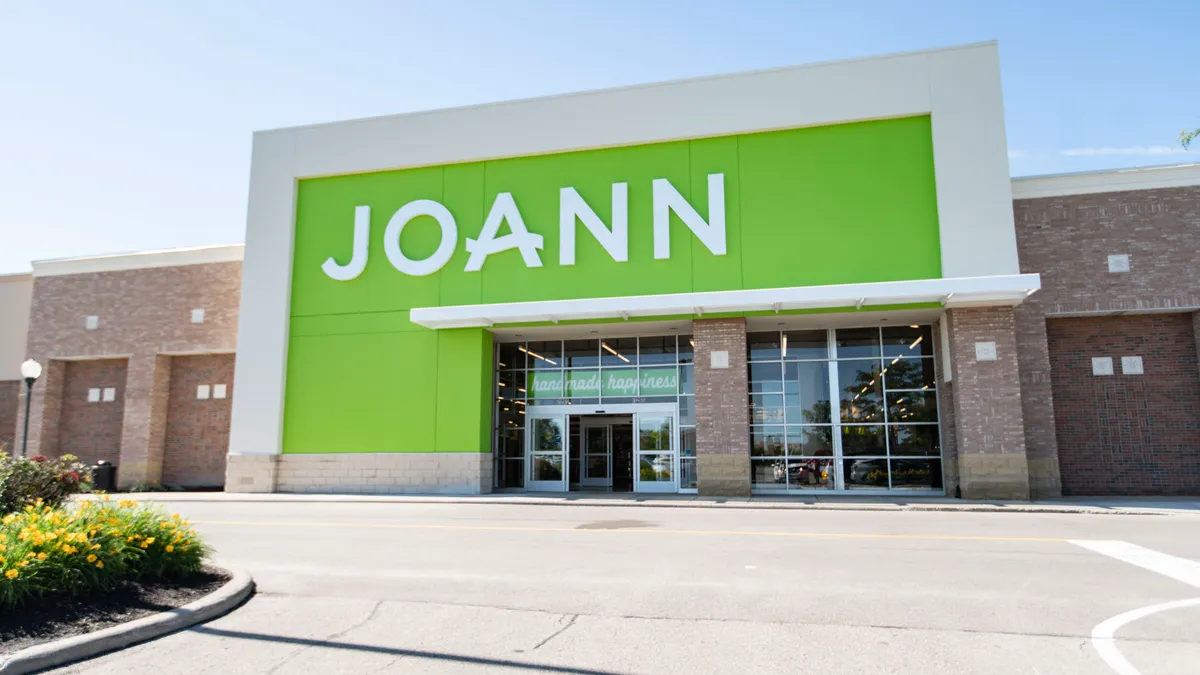Dive Brief:
-
Joann filed for Chapter 11 on Monday with a restructuring plan in place that could allow it to exit the process — as a private company — as early as late next month, according to a press release and documents at the U.S. Bankruptcy Court for the District of Delaware.
-
The sewing and crafts chain has a transaction support agreement with most of its financial stakeholders and other financing parties, including commitments for $132 million in new funds. As a result, Joann expects to reduce its funded debt by about $505 million.
-
Joann also garnered a six-month extension of its asset-based loan and first-in, last-out credit facilities, effective once it exits bankruptcy. In the meantime, stores remain open and “all obligations to employees, vendors, landlords, and other trade creditors will be paid or otherwise satisfied in full and honored in the ordinary course of business,” per the release.
Dive Insight:
This move by Joann is unsurprising given its yearslong struggles.
The retailer has worked to revamp its stores as well as its online operation, but has lost market share as crafting has declined and competition has heated up, according to GlobalData research.
Its most recent spin as a publicly traded company didn’t last long. In early 2021, Joann filed for a $100 million initial public offering. At that point, the retailer seemed to be on the upswing: In the first 10 months of 2020, comp sales had risen by more than 24%. That year, at the height of the pandemic, lockdowns and social distancing orders that kept people at home boosted pursuits like crafting.
But the surge faded as pandemic restrictions lifted. Over the last couple of years, consumer spending has shifted away from discretionary items, and shoppers have grown keen on discounts. For crafters, that has meant more online shopping or switching to lower-priced players like Hobby Lobby, according to GlobalData Managing Director Neil Saunders. But the retailer also has itself to blame to some extent, he said.
“Weakening store standards and declining customer service levels, partly because of staffing cuts, have made stores less desirable,” Saunders said. “On top of this a lot of crafters have found it easier to shop online from a myriad of crafting supply sites. Joann has responded with improvements to its own site, but this has had little impact.”
In September, Joann announced changes to its corporate structure that resulted in the elimination of some positions “from various departments.” In a statement to Retail Dive at the time, the company said that over the previous few months it had restructured both its field and corporate operations “to more closely align our expense and corporate structure to the needs of the business.”
The retailer planned to cut some $200 million in supply chain, product and corporate costs, including through agreements with suppliers on price concessions. Joann raised that target to $225 million in December. The company also closed on a sale-leaseback of its corporate headquarters in Ohio for $34.5 million and planned to use the proceeds to invest in the business.
None of that was enough to prevent bankruptcy. In the third quarter, net sales fell about 4% to $539.8 million, and the company’s long-term debt had grown to $1.14 billion.
“The bankruptcy process will now allow the arts and crafts chain to receive an infusion of cash at the same time as streamlining its operations and reducing debt levels,” Saunders said.
However, the bankruptcy won’t preclude further work to improve operations, he warned. In addition to an e-commerce site, Joann has 815 stores in 49 states, 96% of which are profitable, according to a first-day declaration from Chief Financial Officer Scott Sekella.
“While the restructuring process will address some of the financial challenges, Joann will also need to think about how to craft a better proposition to help it grow the top line,” Saunders said. “For a still-constrained company, this will be a major challenge.”
















